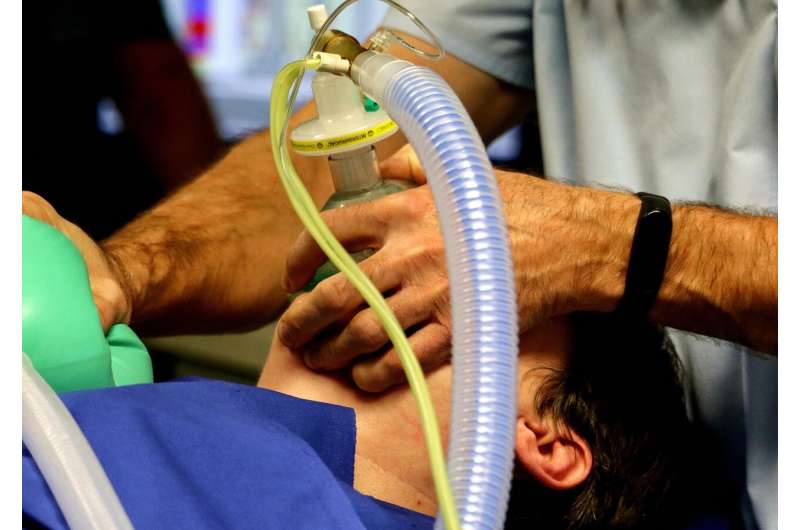This article has been reviewed according to Science X's editorial process and policies. Editors have highlighted the following attributes while ensuring the content's credibility:
fact-checked
peer-reviewed publication
trusted source
proofread
Trial identifies method of emergency intubation preoxygenation to decrease risk of hypoxemia and cardiac arrest

In current clinical care, most critically-ill adults undergoing emergency tracheal intubation receive preoxygenation through an oxygen mask. Administering supplemental oxygen to patients prior to the start of an intubation procedure increases the oxygen content in the patient's lungs and decreases the risk of hypoxemia, low levels of oxygen in the blood.
However, hypoxemia occurs during 10% to 20% of tracheal intubations in the emergency department or intensive care unit and may lead to cardiac arrest and death.
The University of Colorado co-led a trial with Vanderbilt University that compared the two most commonly used methods to preoxygenate patients prior to tracheal intubation: preoxygenation with noninvasive ventilation and preoxygenation with an oxygen mask. The study was published in the New England Journal of Medicine.
The trial, called the Pragmatic Trial Examining Oxygenation Prior to Intubation (PREOXI), was conducted by the Pragmatic Critical Care Research Group (PCCRG) in 24 emergency departments and intensive care units across the United States. Some 120 of the 1,301 patients in the trial were enrolled at the UCHealth University of Colorado Hospital.
The study results revealed that the noninvasive ventilation method, a tight-fitting respiratory mask connected to a bilevel positive airway pressure (BiPAP) machine, which pushes air at a higher pressure into the airway, cut the risk of hypoxemia in half and drastically reduced the risk of cardiac arrest compared to the oxygen mask method.
Adit Ginde, MD, MPH, co-senior principal investigator for the study and professor of emergency medicine in the CU School of Medicine, partnered with the CU Center for COMBAT Medicine and Battlefield (COMBAT) Research.
"We believe the results of this study will change the way we care for our patients across the country and across the world and will lead to better outcomes for this life-saving tracheal intubation procedure," Ginde says. "The [study] sites are very motivated to change and improve clinical care for the U.S. military, the sponsor of this research, and also for the general population."
Significant, practice-changing outcomes
During the trial, critically-ill adults undergoing tracheal intubation were randomly assigned to two groups: preoxygenation using noninvasive ventilation or preoxygenation using an oxygen mask.
The investigators studied whether preoxygenation with the noninvasive ventilation method would prevent hypoxemia during intubation.
In the 1,301 patients enrolled rapidly over a 17-month time period, hypoxemia occurred in 57 of the 624 patients (9.1%) in the noninvasive ventilation group and 118 of the 637 patients (18.5%) in the oxygen mask group.
Further, by preventing hypoxemia during tracheal intubation, preoxygenation with noninvasive ventilation also prevented cardiac arrest, which occurred in one patient (0.2%) in the noninvasive ventilation group and seven patients (1.1%) in the oxygen mask group.
"By using BiPAP, the noninvasive ventilation method, we reduce the amount of this complication of low oxygen levels by half," Ginde says.
"This magnitude of effect is unusual in any clinical trial, let alone a critical care trial, that you improve outcomes this significantly. An important secondary outcome is that the cardiac arrest rate was lower in the noninvasive ventilation group, too."
Prior to this trial, international guidelines stated that preoxygenation with either noninvasive ventilation or an oxygen mask is acceptable, guidance that the results of this trial are likely to change.
Ginde is eager to start implementing changes and recommendations in practice locally and globally. He and his team at the University of Colorado and UCHealth, in partnership with the CU Center for COMBAT Research and the U.S. military, are working on immediate changes to military clinical practice guidelines.
With nine of the study's authors based at CU across the Departments of Emergency Medicine, Medicine, and Anesthesiology, Ginde anticipates a smooth transition to a new standard of practice.
"We have already started clinical implementation at our site, the UCHealth University of Colorado Hospital, as well as all the other PCCRG sites participating in the trial," Ginde says.
"We have also started working with military operational and combatant commands and the Joint Trauma System to change policy and training guidelines."
Ginde emphasizes the team effort and significance of CU's leadership in the study, including its connection to the military.
"This was a big team effort; the PCCRG is a highly effective group of sites and leaders in critical care trials across the country," he says.
More information: University of Colorado Co-Leads Multicenter Randomized Trial Identifying Method of Emergency Intubation Preoxygenation to Decrease Risk of Hypoxemia and Cardiac Arrest, New England Journal of Medicine (2024). DOI: 10.1056/NEJMoa2313680





















